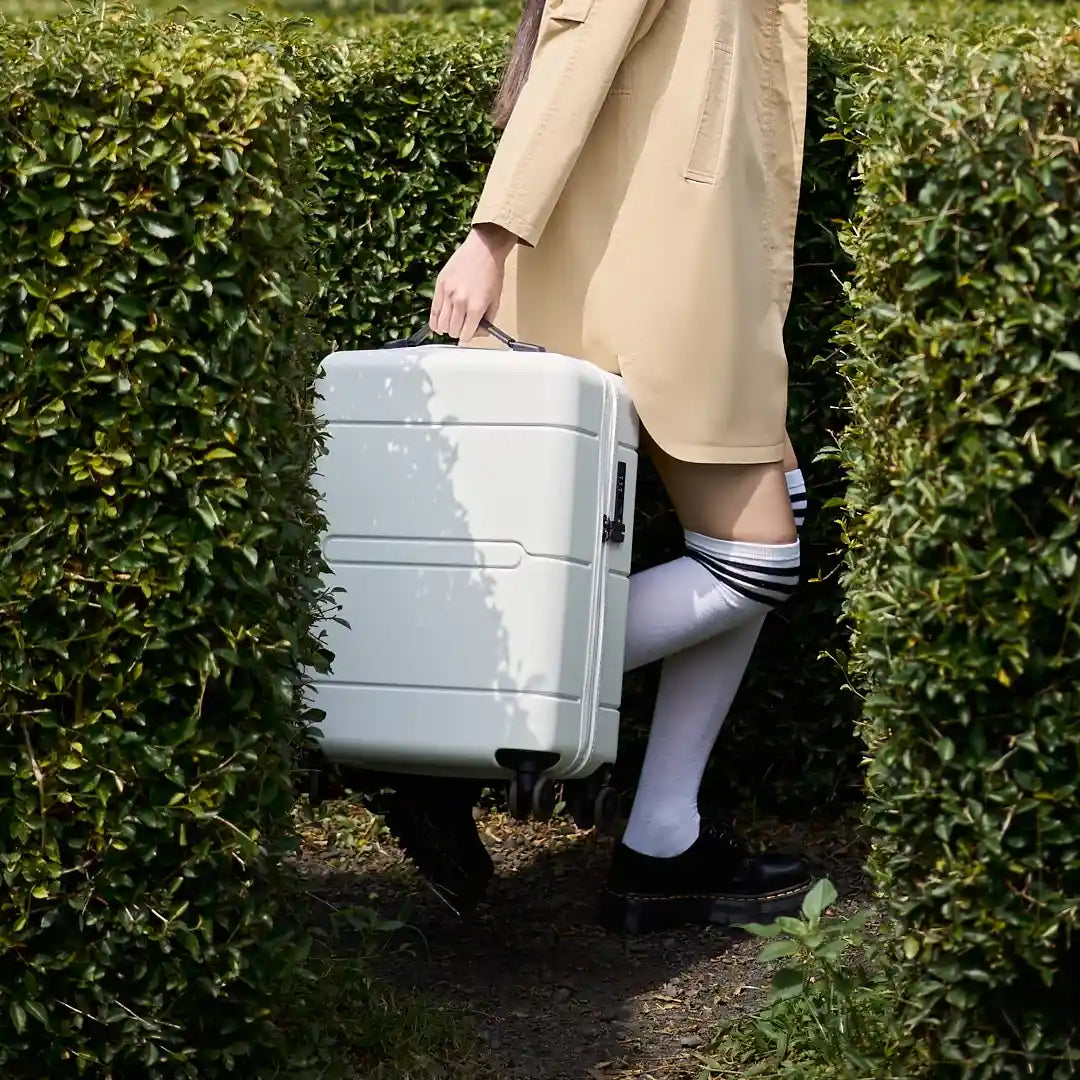Baggage Rules Guide for the World's Top International Airlines

Each airline has its own rules about how much baggage you can bring when flying. These rules may vary depending on your frequent flyer status, the type of ticket you purchase, and your travel route. The information below will help you understand the baggage policies for both checked and carry-on luggage, along with the role that IATA plays in setting industry standards.
The 8 Best International Airlines and Their Baggage Policies
According to the Bounce Airline Index 2023, here are eight of the most prominent international airlines along with their cabin baggage size allowances.
Qatar Airways
Qatar Airways is known for its five-star services and operates out of Hamad International Airport in Qatar. The airport is one of the largest in the world, covering 600,000 square meters with a check-in hall that spans 25,000 square meters and includes 138 counters.
If you're bringing cabin luggage, Qatar Airways allows a maximum size of 50 x 37 x 25 cm. According to their official website, First and Business Class passengers can bring two pieces of carry-on luggage with a total weight of up to 15 kilograms. Economy Class passengers are allowed one piece with a maximum weight of 7 kilograms.
Korean Air
Korean Air, known for its slogan “Excellence in Flight”, has been operating since 1962. It offers extensive routes to 130 cities across 45 countries and is one of the few airlines serving all 6 continents.
There are three travel classes to choose from which are First Class, Prestige Class, and Economy Class. Baggage allowances differ by class, but in general, cabin luggage must not exceed 55 x 40 x 20 cm with a maximum weight of 12 kg.
Singapore Airlines
Singapore Airlines is one of the world’s most recognized airlines. It was named the world's best airline at the 2023 Skytrax World Airline Awards, which are issued by a UK-based aviation ranking agency.
The allowed carry-on baggage size is 40 x 30 x 10 cm with a maximum weight of 7 kg. Additional personal items like a handbag, camera, coat, or baby essentials are permitted, as long as the combined weight does not exceed 6 kg. Extra charges apply for exceeding the free baggage allowance.
Japan Airlines
Japan Airlines has been one of Japan’s leading airlines since 1951 and is a member of the oneworld alliance alongside airlines like Cathay Pacific, Malaysia Airlines, and American Airlines.
Passengers flying in Economy and Premium Economy can bring two checked bags weighing up to 23 kg each. Business and First Class travelers are allowed three checked bags with a maximum weight of 32 kg each.
Cabin luggage should not exceed 55 x 40 x 25 cm and must weigh no more than 10 kg. Oversized or overweight items may need to be checked in. It is recommended not to place valuables or active electronic devices in checked baggage.
Emirates
Emirates is one of the world’s most reputable international airlines based in Dubai. As part of The Emirates Group which is owned by the government of Dubai, it flies to over 150 destinations in 74 countries.
There are three travel classes which include Economy, Premium Economy, Business, and First Class. Economy Class allows cabin baggage up to 55 x 38 x 20 cm with a 7 kg limit. Premium Economy allows the same dimensions but with a 10 kilogram limit.
For Business and First Class, passengers may bring both a carry-on bag and a briefcase or garment bag. A briefcase should not exceed 45 x 35 x 20 cm. A carry-on bag must not exceed 55 x 38 x 22 cm. Garment bags must not be thicker than 20 cm when folded. The total combined weight for these items must not exceed 14 kg with no single item exceeding 7 kg.
All Nippon Airways (ANA)
ANA, based in Tokyo, is another five-star airline according to Skytrax. It serves 49 domestic destinations and 32 international routes. The airline also operates through subsidiaries like ANA Wings, Air Japan, and Air Do.
Baggage allowances vary by class. Economy Class passengers may bring one checked bag up to 23 kg. Business Class travelers are allowed two bags weighing up to 32 kg each. Cabin baggage must not exceed 55 x 40 x 25 cm and should weigh no more than 10 kg.
Vistara
Vistara is a joint venture between Tata Sons Private and Singapore Airlines, officially operating under TATA SIA Airlines Limited. It began operations in January 2015 and is headquartered in Gurgaon with Indira Gandhi International Airport as its hub.
Vistara aims to be the preferred airline in India. Its name comes from the Sanskrit word Vistaar which means limitless expanse. The airline now serves 40 destinations with over 200 flights daily.
Vistara offers three classes which are Economy, Premium Economy, and Business. Economy Class allows cabin bags up to 55 x 40 x 20 cm with a 7 kg weight limit. Premium Economy allows up to 10 kg and Business Class allows up to 12 kg.
Ethiopian Airlines
Ethiopian Airlines offers just two classes which are Economy and Business. In Economy Class, passengers may bring one carry-on item up to 55 x 40 x 23 cm with a 7 kg weight limit. This includes any personal items. Business Class passengers are allowed two carry-on bags with each weighing up to 7 kg. Make sure your carry-on fits the airline’s size and safety guidelines, as it’s not intended for heavy or bulky items like checked bags.
Carry-On Baggage Guidelines for Airline Travel
1. Size and Weight Limits
Most airlines have similar guidelines when it comes to carry-on luggage. Typically, your bag should not exceed 22 inches (56 cm) in length, 18 inches (45 cm) in width, and 10 inches (25 cm) in depth. These measurements include wheels, handles, and side pockets. Some airlines also enforce weight limits, usually starting around 5 kg or 11 lbs.
To avoid unexpected fees, it's a good idea to double-check the carry-on allowance included with your ticket before you fly. Different tickets may include different baggage allowances.
Knowing the right size and weight for your carry-on helps you travel smoother and save on unnecessary charges. Wondering if your 22-inch suitcase will fit in the overhead bin? Check out our complete guide to 22-inch carry-ons and their cabin compatibility in Your Guide to Using a 22 Inch Luggage as Cabin Baggage.
2. Portable Electronics and Lithium Batteries
Lithium batteries in portable devices can pose a fire risk if not handled or packed properly. If you’re bringing spare batteries, power banks, or electronic cigarettes, these items must go in your carry-on luggage, not in checked bags. Each spare battery must be stored separately to avoid short circuits.
The same rule applies to smart luggage with built-in batteries. Mishandling these can be dangerous, so understanding the rules for smart luggage is crucial. To learn more, check out our article about smart luggage restrictions and safe alternatives.
Lithium batteries, often found in portable devices, can be a fire hazard if they’re not packed or handled correctly. If you're bringing power banks, spare batteries, e-cigarettes, or other electronics, make sure to keep them in your carry-on, not in your checked luggage. Spare batteries should be stored separately to prevent short circuits.
This also applies to smart luggage. Since many smart suitcases come with built-in batteries, mishandling them can be dangerous. Understanding airline rules for battery-powered luggage is important, especially if you're a frequent flyer.
3. Sharp Objects
Knives, blades, or sharp tools of any kind aren’t allowed in your carry-on, no matter the material or size. Some sports gear also falls under this rule. These items must go into your checked baggage.
4. Liquids, Aerosols, Gels, and Powders
According to the International Civil Aviation Organization (ICAO), all liquids, aerosols, and gels must be in containers no larger than 100 ml and placed inside a clear, resealable plastic bag with a total capacity of no more than 1 liter.
At security, you’ll need to take this bag out and place it in a separate tray for screening. Exceptions apply to medications, baby formula, and special dietary needs. Some airports also check powders more thoroughly if the amount exceeds 355 ml or 12 ounces.
5. Medical Supplies
If you need to use medical syringes during your flight, such as insulin injections, you’ll need to bring documentation to prove it’s medically necessary. All medical items should be professionally labeled and securely packed. Without proper paperwork, your supplies may be confiscated during security checks.
Checked Baggage Guidelines for Airline Travel
1. Size, Weight, and Number of Bags
According to the International Air Transport Association (IATA), baggage policies can vary depending on the airline, your flight route, ticket type, and even your frequent flyer status. That’s why it’s best to confirm the details with your airline before your trip.
In general, each checked bag should weigh no more than 23 kg or 50 lbs. This limit exists to protect airport staff who lift and handle bags daily. If your bag is too heavy, you might be asked to repack it, or it may be marked as "heavy baggage." In the EU and US, the absolute weight limit for one bag is 32 kg, though some airlines set lower limits.
2. Bag Identification
Lost luggage is often caused by missing or damaged tags. To make sure your bag can always be traced back to you, add a luggage tag with your name, phone number, and email address. It also helps to place a copy of your itinerary inside the bag.
If your tag falls off and the airline has to open the bag, having that extra ID inside can make a big difference in getting your belongings returned quickly.
Ready to travel smarter? Explore Baller luggage crafted for style, durability, and convenience. Visit our official website to find the perfect travel companion and check out exclusive offers on Baller Luggage Collection.












